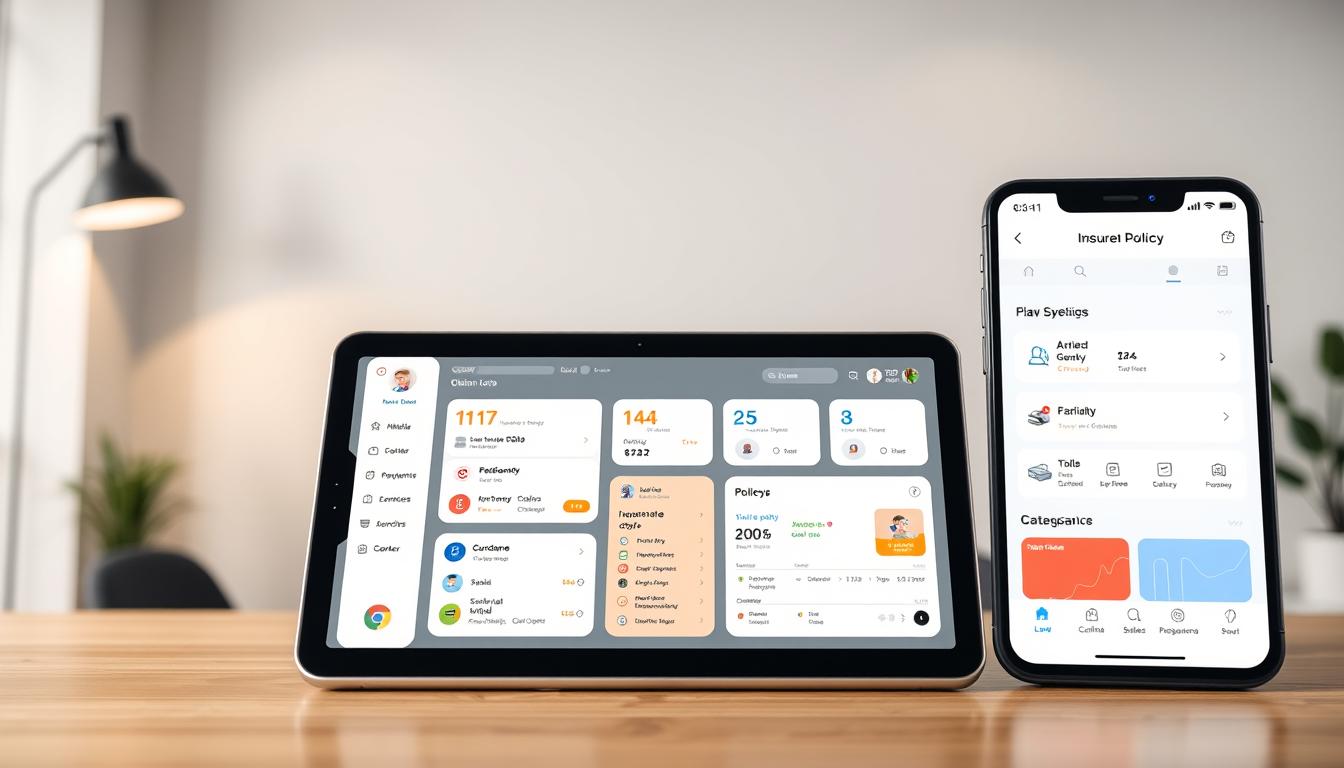This practical roundup spots the leading tools that centralize renewals, payments, and policy access in one place. Mobile apps have reshaped how carriers and agents work, making documents, ID cards, and billing easier to reach from a phone.
Expect clear checks for core management capabilities: security, claims support, telematics, biometric login, and integrated payments that speed renewals.
We cover both consumer-facing tools that simplify personal lines and agency software that streamlines back-office workflows. The focus is real, verifiable functionality like offline ID cards and document storage.
This guide zeroes in on solutions relevant to the United States and explains how a modern app reduces friction across the policy lifecycle. You’ll learn a feature comparison, a top consumer example, the best agency options, and a step-by-step selection framework.
Key Takeaways
- Find apps that centralize renewals, payments, and policy access in one place.
- Evaluate security, claims support, telematics, and integrated payments.
- Look for offline ID cards and biometric login for fast access.
- Compare consumer tools and agency systems for real workflow gains.
- This guide focuses on US-focused, verifiable app features and benefits.
Why Insurance Apps Matter Right Now: Managing Policies Online in the United States
Mobile tools now shape how US policyholders check coverage, file claims, and update account details. Consumers expect a fast app experience that reduces calls and paperwork.
For carriers and agencies, that expectation changes cost and service models. The right mobile app supports renewals, automated reminders, and streamlined communication with clients. That cuts support time and improves customer satisfaction.
Apps make it simple to retrieve ID cards, submit a claim in minutes, and view policy status in real time. They also help people update coverage when they travel, move, or change vehicles.
Digital channels work alongside websites and contact centers. Together they offer fewer steps for payments, document retrieval, and quotes. US privacy rules raise the bar for authentication and data handling, so robust controls are a must.
In short: strong mobile capabilities are now a strategic necessity for growth and retention in the US insurance business.
Key Features to Compare in Mobile Insurance Apps
Compare core functions that keep coverage current and claims moving quickly on mobile interfaces. Focus on clear policy information, quick renewals, and simple document access. These basics cut friction for users and support fast management workflows.

Policy management essentials
Look for a clear display of policy details, easy renewal prompts, and a secure document vault for declarations and endorsements. Status indicators should flag changes so a user can act fast.
Claims handling
Prefer guided photo capture, short forms, and real-time status updates. Automation that fills known fields speeds each claim and lowers manual errors.
Payments and billing
Evaluate payment options such as cards, checking, and digital wallets plus auto-pay, reminders, and billing history. Flexible payments help prevent lapses and ease cash flow.
Security and privacy
Confirm encryption in transit and at rest, short login timeout, and biometric login. Ensure the app discards sensitive transmitted data and limits on-device storage.
User experience and telematics
Assess accessible design, offline access to ID cards, and consistent behavior across devices and websites. For driving programs, require opt-in telematics, clear permission prompts (location, motion, Bluetooth), and transparent data use.
- Example: Progressive’s mobile app supports multiple policy types, offline ID cards, many payment methods, encryption, Touch ID/Face ID, and a 15-minute timeout.
- Uploading photos and video directly in-app speeds appraisals and improves claim status transparency.
Top Consumer-Facing Insurance Apps to Manage Policies Online
Here we review leading mobile interfaces that let drivers and owners view coverage, pay bills, and submit claims fast.
Progressive Mobile App centralizes policy access for Auto, Motorcycle/ATV, Boat/PWC, RV/Trailer, and Snowmobile lines. The app is on the App Store and Google Play and lets new users create an account or sign in with existing website credentials.
Digital ID cards are saved for offline access after login so proof of coverage is available without a signal. Claims flows let users take and submit photos and videos of damage in-app, which speeds assessments and improves documentation for adjusters.

The app supports many payment and billing options: debit/credit (Mastercard, Visa, Discover), checking, Apple Pay, Google Pay, and PayPal. Users can make one-time payments and review billing history quickly.
Security includes end-to-end encryption, no persistent storage of personal data beyond the offline ID card, and a 15-minute inactivity timeout unless Remember Me is selected. Biometric login with Touch ID and Face ID speeds secure access on compatible devices.
Snapshot and Accident Response use consented location and motion/activity data for telematics and driving features. iOS needs Background App Refresh; Android may request Phone, Bluetooth, and disabling battery optimization to capture trips accurately.
- Quick benefits: centralized access, offline ID cards, in-app claims media, broad payments, and purpose-based permissions for privacy.
Best Agency and Broker Tools: Insurance Apps That Streamline Operations
Tools built for brokerages focus on workflow automation, better renewals, and clearer client tracking.
CRM platforms like Salesforce CRM and Zoho CRM centralize customer records, lead tracking, and renewal reminders. They cut duplicate entry and help agents follow up on quotes and renewals faster.
Claims management systems such as ClaimVantage and Guidewire ClaimCenter speed intake, automate routine steps, and give clear status updates for staff and clients.
Policy and document operations
Policy systems—Sapiens PolicyPro and Insly—standardize product setup, commissions, and lifecycle tasks. DocuSign and M‑Files secure signatures and add AI search for documents across teams.
| Function | Example Vendors | Key Benefit | Best For |
|---|---|---|---|
| CRM | Salesforce, Zoho | Centralized client data and renewals | Producer teams |
| Claims | ClaimVantage, Guidewire | Faster intake and analytics | Claims desks |
| Payments & Billing | Stripe, Square | Digital payments and reconciliation | Accounting |
| Quoting & Telematics | Quotit, iPipeline; Root, Drivewise | Multi-carrier quotes; driving-based pricing | Retail distribution |
- Link CRM and policy systems so data flows without double entry.
- Prioritize vendors with solid APIs and security controls.
- Pilot automations for renewals and claims routing before wider rollout.
How to Choose the Right Insurance App for Your Needs
Selecting a mobile solution starts with matching capabilities to real business needs. Map which insurance products you sell and the daily user tasks the tool must support.
Match features to your products
List lines and must-have functions: auto, home, renters, commercial, and specialty lines. Check support for renewals, clear policy summaries, claims intake, and document storage.
Evaluate security posture and compliance
Require encryption in transit and at rest, a short inactivity timeout, and biometric login on eligible devices. Favor minimal on-device storage of sensitive information to protect customer data.
Check integrations
Confirm the app ties into websites, portals, CRM, and payment processors. Smooth integrations prevent duplicate entry and let users switch channels without losing context.
Plan rollout and adoption
Test device compatibility across current iOS and Android versions and verify accessibility standards. Design account setup flows that mirror real cases: Progressive lets users create credentials in-app that also work on the website; existing website credentials should sign in to the mobile app as well.
| Decision Area | What to check | Why it matters | Example |
|---|---|---|---|
| Product support | Lines & features | Keeps customer journeys complete | Auto, home, renters, commercial |
| Security | Encryption, timeout, biometrics | Protects data and builds trust | Biometric login; short timeout |
| Integrations | CRM, websites, payments | Reduces manual work and errors | API-first vendors |
| Rollout | Compatibility, setup, support | Improves adoption and self-service | Pilot groups and training |
- Pilot before wide release and gather user feedback.
- Monitor analytics to measure adoption and friction points.
- Iterate on onboarding, documents handling, and billing flows.
Conclusion
Choose solutions that fit your lines, staff habits, and customer expectations. Match feature sets to product needs and require secure integrations for smooth policy management.
Leading mobile apps streamline everyday work for clients and cut overhead for teams. They make viewing policy details, accessing ID cards, and making payments faster while keeping records consistent.
Shortlist candidates using the feature checklist, run pilots, and validate usability, reliability, and support before wider rollout. Combine CRM, claims, policy, document, and payments tools for end-to-end efficiency.
Keep a customer-first mindset: reduce friction, send timely updates, and measure adoption metrics. Iterate based on feedback so your business can deliver better service, retain clients, and grow sustainably.
FAQ
What are the must-have features in a mobile app for managing policies and claims?
Look for clear policy information, easy renewals, document storage (ID cards, declarations), and status tracking. Claims tools should let you upload photos, submit forms, and follow real‑time claim status. Also check payment options, billing history, and automated reminders for due dates. These features improve customer experience and save time for both clients and agents.
How secure are customer data and documents in these apps?
Reputable providers use encryption in transit and at rest, session timeouts, and biometric login like Touch ID or Face ID. Verify data storage practices and compliance with federal and state privacy rules. Ask about audit logs, role‑based access, and vendor security certifications before sharing sensitive information.
Can I pay my premium and set up auto‑pay from the app?
Yes. Most consumer apps support debit/credit cards, bank (ACH), and digital wallets such as Apple Pay and Google Pay. They also offer auto‑pay enrollment, billing reminders, and payment history so you can manage invoices and receipts in one place.
Do apps offer telematics or safe‑driving programs for auto policies?
Many carriers provide telematics features—usage‑based insurance, driving score feedback, and safe‑driving rewards. These require consent for location, motion, or Bluetooth data. Participating can lower premiums, but review privacy settings and data retention policies first.
Are there offline options if I lose service but need my ID card?
Top apps include offline access to digital ID cards and policy summaries so you can show proof of coverage without cellular or Wi‑Fi. Downloading documents or saving PDFs to your device ensures availability during travel or outages.
How do agency and broker apps differ from consumer apps?
Agency tools focus on workflows: CRM integration, quoting at the point of need, policy admin, document management, and e‑signatures. They enable renewals, commission tracking, and team collaboration, while consumer apps center on policy access, payments, and claims submission.
What integrations should I check when choosing an app for business use?
Ensure compatibility with your website, portals, CRM (Salesforce, Zoho), claims platforms (Guidewire), payment processors (Stripe, Square), and document systems (DocuSign, M‑Files). Smooth integrations reduce duplicate work and improve agent productivity.
How do apps speed up the claims process?
Apps let customers submit photos, complete digital forms, and attach police reports or receipts immediately. Automated triage, push notifications for status changes, and direct chat or call options shorten cycle times and improve transparency.
What should consumers evaluate about user experience across devices?
Check responsive design for phones and tablets, intuitive navigation, clear menus for policies and claims, and accessibility features. Fast load times, minimal clicks to key tasks, and helpful onboarding or in‑app support improve adoption and satisfaction.
Are there specialized apps for commercial and specialty lines?
Yes. Some platforms tailor features for commercial accounts—certificate issuance, multi‑location policies, complex endorsements, and billing splits. Verify that the app supports your product types and delivers required reporting and audit trails.
How do I confirm an app complies with regulations and industry standards?
Request documentation on data encryption, SOC or ISO certifications, privacy policies, and compliance with state insurance regulations. For telematics, ask about consent records and how driving data is used and retained.
Can I get quotes through these mobile solutions?
Many consumer and broker tools offer in‑app quoting or integration with quoting engines like Quotit or iPipeline. This lets agents and customers generate estimates quickly, compare options, and start applications from a phone or tablet.
What payment infrastructure options do agencies typically use?
Agencies often integrate with Stripe, Square, or carrier billing portals to accept card and ACH payments. These systems support recurring billing, reconciliation, and PCI compliance to protect cardholder data.
How do I roll out a new app to my team or customers smoothly?
Plan device compatibility, provide simple account setup guides, run training sessions, and offer in‑app help or a support hotline. Start with a pilot group, collect feedback, and iterate before full deployment to boost adoption.
What are the benefits of telematics‑driven solutions for fleet or personal auto?
Telematics can lower costs through safe‑driving discounts, deliver actionable fleet insights, and help with accident reconstruction. For fleets, it supports route optimization and asset tracking; for individuals, it rewards safe habits and can reduce premiums.

